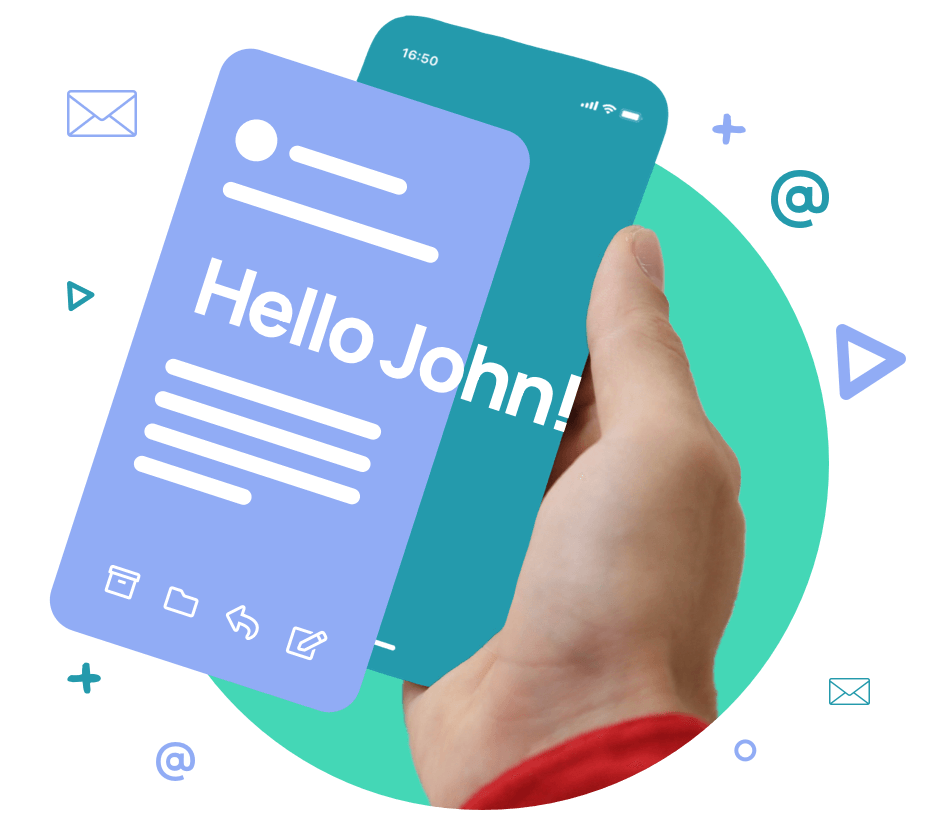Quick Links
Feeling overwhelmed by all the different forms your business needs? You’re not alone!
This Q&A guide will explore the various types of forms commonly used by businesses, helping you choose the right one for any situation.
Our experts are answering here the most frequently asked questions about types of forms, including common form examples and how to make a form.
Q: I need to post a new job opening, but I'm not sure what kind of form to use.
A: There are many different application forms used.
The specific type you’ll need will depend on the job you’re posting and any industry regulations.
However, most application forms will ask for some basic information, such as the candidate’s name, contact information, education, and work experience.
The US Equal Employment Opportunity Commission (EEOC) also has specific guidelines to ensure your application forms are fair and non-discriminatory.
Q: Besides job applications, what other types of forms are there?
A: There are countless types of forms used for a variety of purposes.
Here are a few common examples:
- Registration forms for events: These forms are used to collect information from people who want to attend an event, such as a conference or workshop.
- Medical history forms: These forms collect information about a patient’s medical history, medications, and allergies in accordance with HIPAA (Health Insurance Portability and Accountability Act) regulations.
- Survey forms online: These forms are used to gather information from a group of people about their opinions or experiences. You can see more survey examples in WayMore’s latest blog post.
- Order forms: These forms are used to place an order for a product or service.
- Feedback forms: These forms allow customers to provide feedback about a product, service, or experience.
- Return forms: These forms are used to request a return or exchange of a product, following consumer protection laws.
- Permission slips: These forms are used to obtain permission from a parent or guardian for a child to participate in an activity, following local school district guidelines. Learn all about education conversational forms in WayMore’s latest blog post.
- Loan application forms: These bank forms are used to apply for a loan from a bank or other financial institution, adhering to federal lending regulations.
- Rental application forms: These forms are used to apply to rent an apartment or house, following Fair Housing Act guidelines.
- Volunteer application forms: These forms are used to apply to volunteer for an organization.
This is just a small sampling of the many types of forms that exist.
Q: How do I know which type of form to use?
A: The first step is absolutely identifying the goal of your form. What information do you need to collect?
Here’s a breakdown of common business goals and the types of forms to achieve them:
1. Goal: Building Your Email List
- Best Form Type: Subscription Signup Form
- Specs: Keep it short and sweet! Aim for one or two fields, typically just email address or email address and first name.
- Expert Tip: Offer an incentive (like a discount code) to encourage signups.
2. Goal: Gathering Customer Feedback
- Best Form Types: Feedback Forms & Customer Satisfaction Surveys
- Specs: Feedback forms can be quick and easy with star ratings or smileys for basic feedback.
- Customer satisfaction surveys can delve deeper with multiple-choice questions, open-ended sections, and Likert scales for in-depth insights.
- Expert Tip: Keep surveys concise and avoid overwhelming users.
3. Goal: Processing Orders
- Best Form Type: Secure Order Form
- Specs: Integrate with a secure payment gateway to collect billing and shipping information along with order selections.
- Expert Tip: Simplify the checkout process with auto-fill features and clear product details.
4. Goal: Accepting Applications (Jobs, Loans, Scholarships, etc.)
- Best Form Type: Application Form
- Specs:The format can vary depending on the application type.
- Generally, collect basic information like resumes, references, contact details, and relevant experience.
- Security is crucial! Ensure data encryption for sensitive information.
- Expert Tip: Provide clear instructions and outline required documents for a smooth application process. Conversational forms are a great fit here.
5. Goal: Registering Attendees for Events
- Best Form Type: Event Registration Form
- Specs: Collect attendee details like name, contact information, dietary restrictions (for in-person events), and potentially session preferences.
- Expert Tip: Offer options for multiple attendees and consider ticket tiers or pricing structures.
6. Goal: Allowing User Contact
- Best Form Type: Contact Form
- Specs: Provide a simple way for website visitors to send messages or request information.
- Expert Tip: Include multiple contact options (like email and phone number) for user convenience.
7. Goal: Facilitating Product Downloads
- Best Form Type: Downloadable Form (PDF format)
- Specs: Sometimes pre-made forms are more efficient (e.g., applications, legal documents).
- Users can download the form, fill it out locally, and then submit it electronically or by mail.
- Expert Tip: Clearly label the downloadable form and provide concise download instructions.
Remember: This is not an exhaustive list. Many other specialized forms exist, and the best choice depends on your specific needs. Always prioritize user-friendliness and focus on collecting essential information only to ensure a smooth user experience and high completion rates.
While traditional forms still have a place for specific needs like secure data collection, conversational forms are the future of user-friendly data collection. Their engaging, step-by-step approach makes them ideal for a wide range of goals, from building email lists to gathering customer feedback.
The key takeaway? Consider incorporating conversational forms into your strategy to improve user experience, boost completion rates, and achieve your business objectives more effectively.
Q: Is there anything else I can do to make sure my form gets filled out correctly?
A: Beyond contacting the organization that provided the form, here are some proactive steps you can take to ensure a smooth and accurate completion process:
- Pre-fill information when possible: Many forms allow you to pre-populate certain fields with existing data. Take advantage of this feature to reduce typing and potential errors, especially for repetitive information like name, email address, or phone number. Look for forms that integrate with auto-fill functionality on your browser or device.
- Leverage clear and consistent formatting: Ensure the form uses consistent formatting and layout throughout. This includes using clear fonts, appropriate font sizes, and adequate spacing between fields. A well-organized and visually appealing form is easier on the eyes and reduces the chance of users missing crucial information.
- Offer clear error messages and validation: Implement clear and specific error messages to guide users if they enter incorrect information. For example, instead of a generic “invalid entry” message, indicate if a field requires a specific format (e.g., “Please enter a valid email address” or “Phone numbers require only digits”). This helps users identify and rectify errors quickly.
- Consider data validation rules: Utilize data validation rules to ensure users enter information in the correct format. For instance, phone number fields should only accept numerical digits, while email fields should adhere to a standard email format. Data validation helps prevent errors and streamlines the data collection process.
- Provide optional fields strategically: While some information may be crucial, avoid overwhelming users with too many mandatory fields. Clearly distinguish required fields from optional ones. Consider using radio buttons or checkboxes for optional selections to improve readability and user experience.
- Proofread your form meticulously: Before publishing your form, double-check for any typos, grammatical errors, or unclear wording. Inaccurate information can lead to confusion and discourage users from completing the form.
By following these tips, you can significantly improve the accuracy and completion rate of your forms.
Q: How can I ensure a smooth user experience when designing long and complex forms?
A: Lengthy forms can discourage completion.
Here are some strategies to improve the user experience:
- Break down the form into sections: Divide the form into logical sections with clear titles. This makes the form appear less daunting and allows users to focus on one section at a time.
- Use progress indicators: Implement a progress bar or indicator to show users how far they’ve progressed through the form.
- Offer clear instructions and tooltips: Provide concise instructions at the beginning of the form and offer helpful tooltips beside specific fields for additional guidance.
- Allow users to save and resume later: Enable users to save their progress and return to complete the form later, especially beneficial for lengthy applications.
- Utilize conditional logic: Employ conditional logic to display questions relevant to the user’s previous answers. This streamlines the process by eliminating irrelevant questions.
Follow these tips to create user-friendly forms for your business. This will help encourage completion and improve data collection efficiency.
Our latest blog post explains how to design lead capture conversational forms. Dont’s miss it!
Q: How can I create my own custom form?
A: Many online tools, like WayMore.io, empower businesses to build their own forms. These tools offer various features, like adding different question types (text boxes, drop-down menus) and even using conversational forms.
Conversational forms break down lengthy forms into a series of short, easy-to-answer questions. This makes filling out the form more engaging and user-friendly, especially for people using mobile devices.
Q: Can you tell me more about form design examples?
A: Sure! Here are a few things to keep in mind when designing your own form:
- Keep it simple: Avoid using too many types of form fields or asking for unnecessary information.
- Use clear and concise language: Make sure your questions are easy to understand.
- Make it visually appealing: A well-designed form will be more user-friendly.
- Test your form before you use it: Make sure it works properly and is easy to fill out.
By following these tips, you can create forms that are both effective and user-friendly.
If you need more inspiration, explore 7 examples of conversational forms, the future of forms, which showcase how design can make filling out information a breeze.
Q: Is there anything else I should know?

A: Here are a few additional things to keep in mind about forms:
- Security: Ensure your forms use HTTPS encryption to protect user data during submission.
- Privacy: Clearly display a privacy policy on your website outlining how collected information will be used, stored, and secured.
- Accessibility: Follow WCAG (Web Content Accessibility Guidelines) to ensure your forms are accessible to users with disabilities. This may include features like descriptive labels, keyboard navigation, and screen reader compatibility.
- Data Validation: Implement data validation rules to ensure users enter information in the correct format (e.g., requiring numbers for phone fields, email format for email fields).
- Clear Instructions: Provide clear and concise instructions throughout the form to guide users and avoid confusion.
By following these best practices, you can create forms that are secure, user-friendly, and gather the information you need effectively.
Conclusion
Choosing the right form ensures you collect the necessary information efficiently. Conversational form platforms are a new technology simplifying complex forms for users, especially on mobile devices.
Key Takeaways:
- Security: Protect user data with HTTPS encryption.
- Privacy: Clearly explain how information is used and secured.
- Accessibility: Make forms usable for everyone.
- Data Validation: Ensure users enter information correctly.
- Clear Instructions: Guide users to avoid confusion.
By following these tips and exploring new technologies, you can create effective and user-friendly forms that contribute to your business success.
Curious to learn more? WayMore’s experts are ready to chat!




